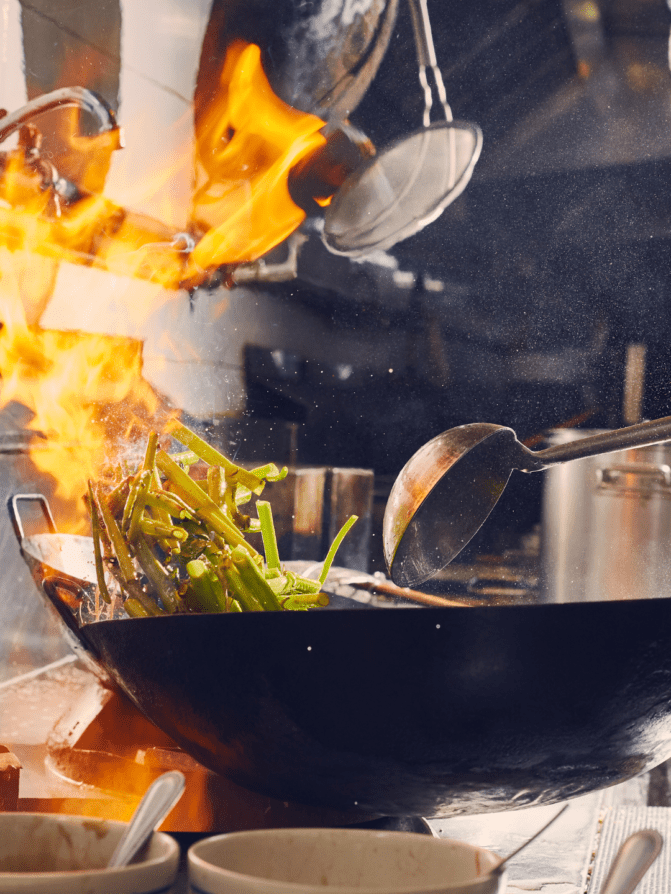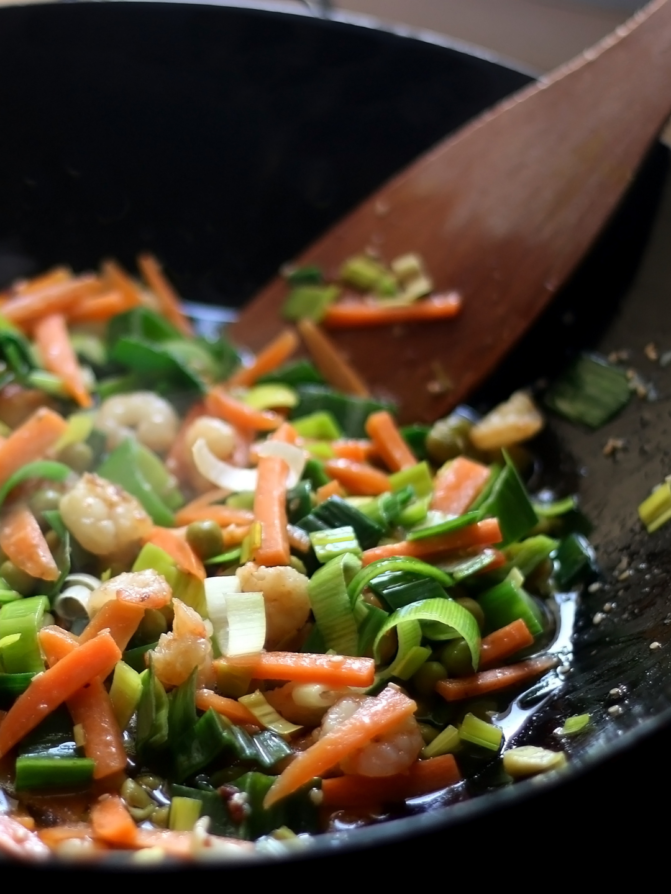The Fundamentals of a Stir Fry

The Fundamentals of a Stir Fry

To begin with, a stir fry should involve an extremely hot pan — traditionally and for best results a wok, (although we’ll talk more on that in a moment) — a splash of high-smoke point oil and should be served right away.
One of the main selling points of stir fry is that, by cooking so hot and quick, it scorches out ingredients’ natural aromas and brightens their flavors without drying them out as would be the case in a lower heat technique with a longer cooking time.
About the Wok
In ideal circumstances, there is simply no beating a wok and flame for stir fry. Its heat conduction is unmatched and the distribution ideal — from there the physics of the wok, the technique of tossing the ingredients, and the interplay of those characteristics with the ingredients’ chemistry creates dynamic flavors and mouthfeel that can’t be imitated.
The skill of the frequent tossing and flipping takes time and reps to perfect, but it’s the technique that’s drastically different on a wok than other pans. This allows the ingredients to cook on intense heat without burning.
That technique, alongside the shape and conductivity of a wok, has other significance: Ingredients are almost constantly passing through different zones of heat — they’re moving between the high heat of the oil at the bottom of the wok up to the top, where the slight steam adds a softer element of cooking. Of course, more steam would make your stir fry soggy, but the lightning-fast back-and-forth of intense searing and light steam combines perfectly.
That being said, in modern North America, most of us don’t have access to a fire to cook on, even if some have a gas stove whose flame is less intense but still works. But if you have an electric or induction stove, using a big wok with a round bottom — superior for getting the ideal intensity and distribution of heat — is, uh, not super doable.
And while absolutely nothing beats the real thing, you got to work with what you’ve got! And luckily there are wok substitutes that are still pretty alright.
For example, certain modern woks come with a flat bottom that allows them to sit on top of the stove. Generally, if you must use an alternative, this is your best bet. Otherwise, a Western-style skillet pan is… fine, not great. If that’s what you have, go for it! You’ll still be able to make delicious, stir-fried dishes; they just won’t have quite that same brightly scorched, complex flavor and texture.
Also, if you must use a skillet, make sure to not overcrowd the pan. A pan already will be distributing heat differently and thus won’t achieve the same intensity — crowding the pan will exacerbate that issue and sog down your ingredients.

How to think about your ingredients, plus tips to get the most out of them
First thing’s first, the order of ingredients matters; while stir frying gives you a lot of freedom to cook with your instincts and senses instead of measuring things out and being ultra-precise, if you put in snap peas before beef strips, you’re not going to have a great time.
Generally, after getting the wok super-hot and splashing some oil in, you’ll throw in your aromatics like ginger, chilies, and garlic just for a few moments, then add meat if you’re including any, then vegetables. If you’re including noodles, they’ll probably be nearer to the end to like in this recipe for stir fried noodles with oyster sauce.
Another way to think of it is aromatics first to prime the dish’s flavor, then everything else in order of how quickly it cooks. Meat of course almost always needs to cook longer than veggies (other than certain super thin-cut slices like sukiyaki, but that’s another article all together), and certain vegetables like broccoli will need to cook longer than, say, spinach.
Also, this is a good point to mention that you’re best off having your ingredients chopped and ready to go before starting; stir frying goes so fast that if you try to prepare ingredients when others are already cooking, you’ll probably end up with a mess on your hands if not a fully burnt meal.
Meat for a stir fry should be relatively thinly cut and, crucially, tender on its own and free of connective tissue. If you’re an experienced cook, you knew this intuitively when we mentioned wok stir frying as high heat and quick. This is as opposed to tougher cuts with more fat and tissue that are perfect for braising and other methods of low heat for hours and hours on end (which, again, would take up its own article).
Good meat for a stir fry includes chicken, lean beef like flank or skirt steak, or pork tenderloin. This kimchi pork recipe is a good example, as is this crispy stir fried chicken recipe that involves a couple more steps than simpler stir fry but is absolutely tasty.
If you’re a tofu fan, we recommend going with firm or extra firm — softer tofu isn’t impossible, but it will disintegrate quite easily. And if you’re using seafood, make sure not to overcook it! Fish, shellfish, octopus, squid, etc. get quite chewy and unappetizing if overcooked, and it’s quite easy to do.
Otherwise, when in doubt, cook with your senses! This tip is universal, but it’s especially true about stir frying. You should smell the flavors and hear that sizzle!
Stir fry is cheeky — it talks back to you. Listen, follow along, and you’ll start creating some healthy, quick, and super delicious dishes.




